Vue renderder
as we know, vue use the diff algorithm to update the dom tree with vnode(which used when ends are ArrayPatch
Double ended diff in vue2
(tips: sorry, I don’t know if it’s called, but just call it that now), firstly, we will know the basic diff algorithm.
basic diff
const oldChildren = n1
const newChildren = n2
// we use `lastIndex` to record the most biggest `index` of the oldChildren
let lastIndex = 0
for (let i = 0; i < newChildren.length; i++) {
const newVNode = newChildren[i]
for (let j = 0; j < oldChildren.length; j++) {
if (oldChildren[j].key === newVNode.key) {
const oldVNode = oldChildren[j]
// patch
patch(oldVNode, newVNode, container)
if (j < lastIndex) {
// move
const prevVNode = newChildren[i - 1]
if (prevVNode) {
const anchor = prevVNode.el.nextSibling
insert(newVNode.el, container, anchor)
}
}
else {
lastIndex = j
}
break
}
}
}
const oldChildren = n1
const newChildren = n2
// we use `lastIndex` to record the most biggest `index` of the oldChildren
let lastIndex = 0
for (let i = 0; i < newChildren.length; i++) {
const newVNode = newChildren[i]
for (let j = 0; j < oldChildren.length; j++) {
if (oldChildren[j].key === newVNode.key) {
const oldVNode = oldChildren[j]
// patch
patch(oldVNode, newVNode, container)
if (j < lastIndex) {
// move
const prevVNode = newChildren[i - 1]
if (prevVNode) {
const anchor = prevVNode.el.nextSibling
insert(newVNode.el, container, anchor)
}
}
else {
lastIndex = j
}
break
}
}
}
some cases
newChildren.length greater than oldChildren.length
newChildren.length less than oldChildren.length
let find = false
for (let i = 0; i < newChildren.length; i++) {
// ...
for (let j = 0; j < oldChildren.length; j++) {
if (oldChildren[j].key === newVNode.key) {
// add this
find = true
// ...
if (j < lastIndex) {
// ...
}
else {
// ...
}
break
}
// add following code maybe work well to delete el in children which not in the `newChildren`
// else {
// unmount(oldChildren[j])
// }
}
}
// there means that the newVNode is not in the oldChildren, so we should add it
if (!find) {
const prevVNode = newChildren[i - 1]
let anchor = null
if (prevVNode)
anchor = prevVNode.el.nextSibling
else
anchor = container.firstChild
insert(null, newVNode, container, anchor)
}
// there means that the oldVNode is not in the newChildren, so we should remove it
for (let i = 0; i < oldChildren.length; i++) {
const oldVNode = oldChildren[i]
const find = newChildren.find(el => el.key === oldVNode.key)
if (!find)
unmount(oldVNode.el)
}
let find = false
for (let i = 0; i < newChildren.length; i++) {
// ...
for (let j = 0; j < oldChildren.length; j++) {
if (oldChildren[j].key === newVNode.key) {
// add this
find = true
// ...
if (j < lastIndex) {
// ...
}
else {
// ...
}
break
}
// add following code maybe work well to delete el in children which not in the `newChildren`
// else {
// unmount(oldChildren[j])
// }
}
}
// there means that the newVNode is not in the oldChildren, so we should add it
if (!find) {
const prevVNode = newChildren[i - 1]
let anchor = null
if (prevVNode)
anchor = prevVNode.el.nextSibling
else
anchor = container.firstChild
insert(null, newVNode, container, anchor)
}
// there means that the oldVNode is not in the newChildren, so we should remove it
for (let i = 0; i < oldChildren.length; i++) {
const oldVNode = oldChildren[i]
const find = newChildren.find(el => el.key === oldVNode.key)
if (!find)
unmount(oldVNode.el)
}
in the basic , the time complexity
Double ended diff
this is the patch diff algorithm of vue
how it is working ? we add four PointerkeyoldChildrennewChildrensamedifferentsamedifferentsame
1. find same key
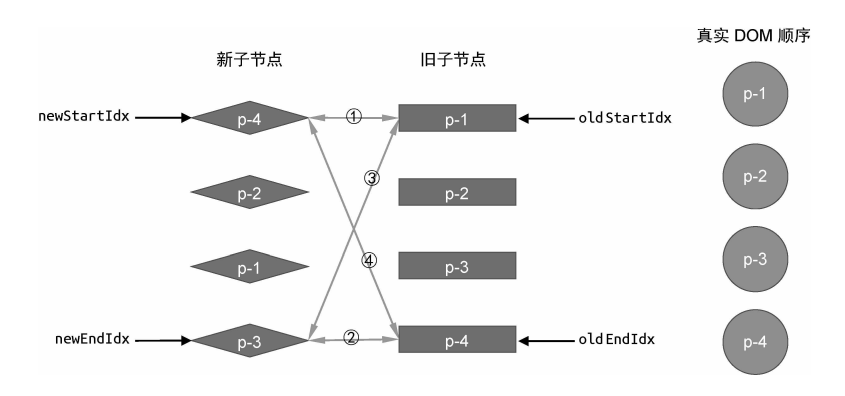
we make judgments in the order in the picture, and move in sequence after.
const oldStartIdx = oldChildren[0]
const oldEndIdx = oldChildren[oldChildren.length - 1]
const newStartIdx = newChildren[0]
const newEndIdx = newChildren[newChildren.length - 1]
const oldStartVNode = oldChildren[oldStartIdx]
const oldEndVNode = oldChildren[oldEndIdx]
const newStartVNode = newChildren[newStartIdx]
const newEndVNode = newChildren[newEndIdx]
// eslint-disable-next-line no-unmodified-loop-condition
while (oldStartIdx < oldEndIdx && newStartIdx < newEndIdx) {
// eslint-disable-next-line no-empty
if (oldStartVNode.key === newStartVNode.key) {
}
// eslint-disable-next-line no-empty
else if (oldEndVNode.key === newEndVNode.key) {
}
// eslint-disable-next-line no-empty
else if (oldStartVNode.key === newEndVNode.key) {
}
// eslint-disable-next-line no-empty
else if (oldEndVNode.key === newStartVNode) {
}
}
const oldStartIdx = oldChildren[0]
const oldEndIdx = oldChildren[oldChildren.length - 1]
const newStartIdx = newChildren[0]
const newEndIdx = newChildren[newChildren.length - 1]
const oldStartVNode = oldChildren[oldStartIdx]
const oldEndVNode = oldChildren[oldEndIdx]
const newStartVNode = newChildren[newStartIdx]
const newEndVNode = newChildren[newEndIdx]
// eslint-disable-next-line no-unmodified-loop-condition
while (oldStartIdx < oldEndIdx && newStartIdx < newEndIdx) {
// eslint-disable-next-line no-empty
if (oldStartVNode.key === newStartVNode.key) {
}
// eslint-disable-next-line no-empty
else if (oldEndVNode.key === newEndVNode.key) {
}
// eslint-disable-next-line no-empty
else if (oldStartVNode.key === newEndVNode.key) {
}
// eslint-disable-next-line no-empty
else if (oldEndVNode.key === newStartVNode) {
}
}
we will finished these cases that move the same
move it
while (oldStartIdx < oldEndIdx && newStartIdx < newEndIdx) {
if (oldStartVNode.key === newStartVNode.key) {
patch(oldStartVNode, newStartVNode, container)
// next
oldStartVNode = oldChildren[++oldStartIdx]
newStartVNode = newChildren[++newStartIdx]
}
else if (oldEndVNode.key === newEndVNode.key) {
patch(oldEndVNode, newEndVNode, container)
// next
oldEndVNode = oldChildren[--oldEndIdx]
newEndVNode = newChildren[--newEndIdx]
}
else if (oldStartVNode.key === newEndVNode.key) {
patch(oldStartVNode, newEndVNode, container)
// move `oldStartVNode` to after `oldEndVNode`
insert(oldStartVNode.el, container, oldEndVNode.el.nextSibling)
oldStartVNode = oldChildren[++oldStartIdx]
newEndVNode = newChildren[--newEndIdx]
}
else if (oldEndVNode.key === newStartVNode.key) {
patch(oldEndVNode.el, container, newStartVNode.el)
// move `oldEndVNode` to before the `oldStartVNode`
insert(oldEndVNode.el, container, oldStartVNode.el)
oldEndVNode = oldChildren[--oldEndIdx]
newStartVNode = newChildren[++newStartIdx]
}
}
while (oldStartIdx < oldEndIdx && newStartIdx < newEndIdx) {
if (oldStartVNode.key === newStartVNode.key) {
patch(oldStartVNode, newStartVNode, container)
// next
oldStartVNode = oldChildren[++oldStartIdx]
newStartVNode = newChildren[++newStartIdx]
}
else if (oldEndVNode.key === newEndVNode.key) {
patch(oldEndVNode, newEndVNode, container)
// next
oldEndVNode = oldChildren[--oldEndIdx]
newEndVNode = newChildren[--newEndIdx]
}
else if (oldStartVNode.key === newEndVNode.key) {
patch(oldStartVNode, newEndVNode, container)
// move `oldStartVNode` to after `oldEndVNode`
insert(oldStartVNode.el, container, oldEndVNode.el.nextSibling)
oldStartVNode = oldChildren[++oldStartIdx]
newEndVNode = newChildren[--newEndIdx]
}
else if (oldEndVNode.key === newStartVNode.key) {
patch(oldEndVNode.el, container, newStartVNode.el)
// move `oldEndVNode` to before the `oldStartVNode`
insert(oldEndVNode.el, container, oldStartVNode.el)
oldEndVNode = oldChildren[--oldEndIdx]
newStartVNode = newChildren[++newStartIdx]
}
}
in there, we finish basic cases, we will consider other special situations.
special situations
no same key when the loop
newChildren.length greater than oldChildren.length
newChildren.length less than oldChildren.length
// no same key when the loop
while (oldStartIdx <= oldEndIdx && newStartIdx <= newEndIdx) {
if (!oldStartVNode) {
oldStartVNode = oldChildren[++oldStartIdx]
}
else if (!oldEndVNode) {
oldEndVNode = oldChildren[--oldEndIdx]
}
else if (oldStartVNode.key === newStartVNode.key) {
// ...
}
else if (oldEndVNode.key === newEndVNode.key) {
// ...
}
else if (oldStartVNode.key === newEndVNode.key) {
// ...
}
else if (oldEndVNode.key === newStartVNode.key) {
// ...
}
else {
// find the same key in the newStartVNode of newChildren
const idxInOld = oldChildren.findIndex(
node => node.key === newStartVNode.key
)
if (idxInOld > 0) {
const vnodeToMove = oldChildren[idxInOld]
patch(vnodeToMove, newStartVNode, container)
insert(vnodeToMove.el, container, oldStartVNode.el)
oldChildren[idxInOld] = undefined
}
else {
// add newStartVNode to before the oldStartVNode
patch(null, newStartVNode, container, oldStartVNode.el)
}
newStartVNode = newChildren[++newStartIdx]
}
}
// delete the oldChildren which is not used
if (oldEndIdx < oldStartIdx && newStartIdx <= newEndIdx) {
for (let i = oldStartIdx; i <= oldEndIdx; i++)
unmount(oldChildren[i])
}
// no same key when the loop
while (oldStartIdx <= oldEndIdx && newStartIdx <= newEndIdx) {
if (!oldStartVNode) {
oldStartVNode = oldChildren[++oldStartIdx]
}
else if (!oldEndVNode) {
oldEndVNode = oldChildren[--oldEndIdx]
}
else if (oldStartVNode.key === newStartVNode.key) {
// ...
}
else if (oldEndVNode.key === newEndVNode.key) {
// ...
}
else if (oldStartVNode.key === newEndVNode.key) {
// ...
}
else if (oldEndVNode.key === newStartVNode.key) {
// ...
}
else {
// find the same key in the newStartVNode of newChildren
const idxInOld = oldChildren.findIndex(
node => node.key === newStartVNode.key
)
if (idxInOld > 0) {
const vnodeToMove = oldChildren[idxInOld]
patch(vnodeToMove, newStartVNode, container)
insert(vnodeToMove.el, container, oldStartVNode.el)
oldChildren[idxInOld] = undefined
}
else {
// add newStartVNode to before the oldStartVNode
patch(null, newStartVNode, container, oldStartVNode.el)
}
newStartVNode = newChildren[++newStartIdx]
}
}
// delete the oldChildren which is not used
if (oldEndIdx < oldStartIdx && newStartIdx <= newEndIdx) {
for (let i = oldStartIdx; i <= oldEndIdx; i++)
unmount(oldChildren[i])
}
so far, the double ended diff algorithm is finished. the time complexity
fast diff in vue3
double ended diff is not the best performance for vue, Introduced fast diff
how is it working ?
it is like the String
const oldNode = 'this is a good day'
const newNode = 'this is a bad day'
const oldNode = 'this is a good day'
const newNode = 'this is a bad day'
how we patch it that between oldNodenewNode
generally speaking, we just make oldNode = newNodefast diff
firstly, we will compare the start and end endpoints of oldNode and newNode until they are not equal.
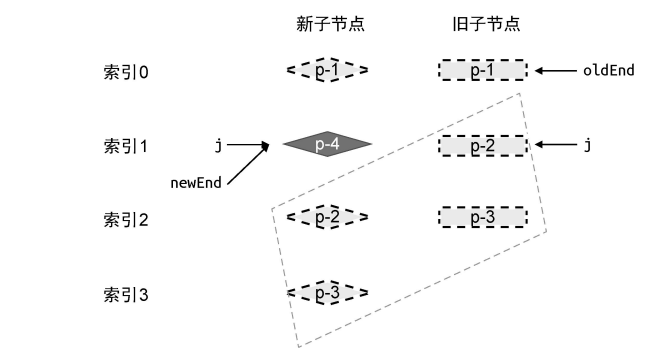
const oldChildren = n1.children
const newChildren = n2.children
let j = 0
let oldVNode = oldChildren[j]
let newVNode = newChildren[j]
while (oldNode.key === newNode.key) {
patch(oldVNode, newVNode, container)
j++
oldVNode = oldChildren[j]
newVNode = newChildren[j]
}
let newEnd = newChildren.length - 1
let oldEnd = oldChildren.length - 1
oldVNode = oldChildren[oldEnd]
newVNode = newChildren[newEnd]
while (oldVNode.key === newVNode.key) {
patch(oldVNode, newVNode, container)
oldVNode = oldChildren[--oldEnd]
newVNode = newChildren[--newEnd]
}
const oldChildren = n1.children
const newChildren = n2.children
let j = 0
let oldVNode = oldChildren[j]
let newVNode = newChildren[j]
while (oldNode.key === newNode.key) {
patch(oldVNode, newVNode, container)
j++
oldVNode = oldChildren[j]
newVNode = newChildren[j]
}
let newEnd = newChildren.length - 1
let oldEnd = oldChildren.length - 1
oldVNode = oldChildren[oldEnd]
newVNode = newChildren[newEnd]
while (oldVNode.key === newVNode.key) {
patch(oldVNode, newVNode, container)
oldVNode = oldChildren[--oldEnd]
newVNode = newChildren[--newEnd]
}
in here, we will find some cases that:
- newChildren.length greater than oldChildren.length

- newChildren.length less than oldChildren.length
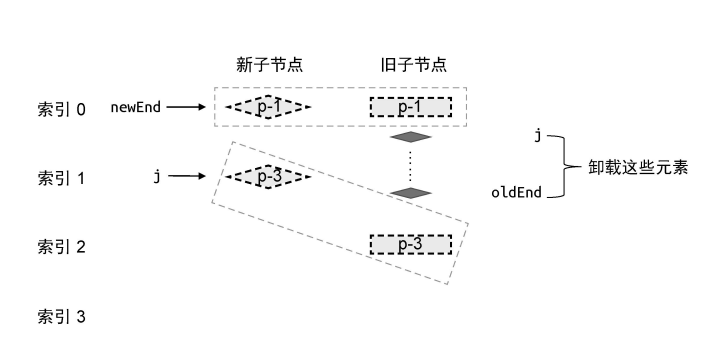
// while(){
// //...
// }
// while(){
// //...
// }
if (j > oldEnd && j <= newEnd) {
const anchorIndex = newEnd + 1
const anchor = anchorIndex < newChildren.length
? newChildren[anchorIndex].el
: null
while (j < newEnd)
patch(null, newChildren[j++], container, anchor)
}
else if (j > newEnd && j <= oldEnd) {
// j -> oldEnd 之间的节点应该被卸载
while (j <= oldEnd)
unmount(oldChildren[j++])
}
// while(){
// //...
// }
// while(){
// //...
// }
if (j > oldEnd && j <= newEnd) {
const anchorIndex = newEnd + 1
const anchor = anchorIndex < newChildren.length
? newChildren[anchorIndex].el
: null
while (j < newEnd)
patch(null, newChildren[j++], container, anchor)
}
else if (j > newEnd && j <= oldEnd) {
// j -> oldEnd 之间的节点应该被卸载
while (j <= oldEnd)
unmount(oldChildren[j++])
}
complex case:
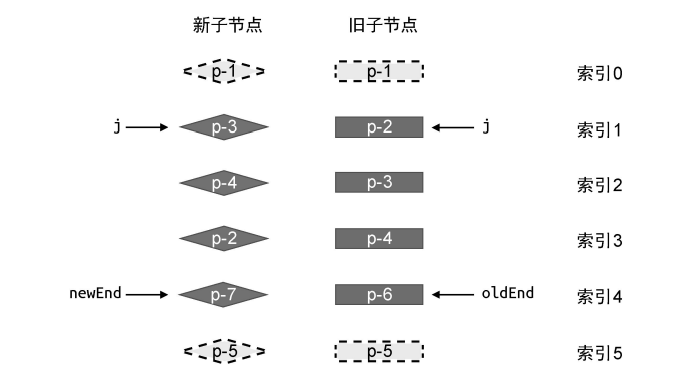
after above all, we will maintain the ArraysourceindexnewVNode.keyoldChildrensource[2,3,1,-1]-1keyoldChildren
how do we determine whether a node needs to be move it ?
it’s like basic difflastIndex
See the following code:
if (j > oldEnd && j <= newEnd) {
// ...
}
else if (j > newEnd && j <= oldEnd) {
// ...
}
else {
const count = newEnd - j + 1
const source = Array(count).fill(-1)
const newStart = j
const oldStart = j
// get key
const keyIndex = {}
for (let i = newStart; i < newEnd; i++)
keyIndex[newChildren[i].key] = i
let pos = 0
let move = false
let patched = 0
for (let i = oldStart; i < oldEnd; i++) {
oldVNode = oldChildren[i]
if (patched < count) {
const k = keyIndex[oldVNode.key]
if (typeof k !== 'undefined') {
newVNode = newChildren[k]
patch(oldVNode, newVNode, container)
source[k - newStart] = i
patched++
if (pos < k) {
// move
move = true
}
else {
pos = k
}
}
else {
// cant find
unmount(oldVNode)
}
}
else {
// in here,it is meaning that oldChildren.length greater than newChildren.length, so we should remove the redundant nodes
unmount(oldVNode)
}
}
}
if (j > oldEnd && j <= newEnd) {
// ...
}
else if (j > newEnd && j <= oldEnd) {
// ...
}
else {
const count = newEnd - j + 1
const source = Array(count).fill(-1)
const newStart = j
const oldStart = j
// get key
const keyIndex = {}
for (let i = newStart; i < newEnd; i++)
keyIndex[newChildren[i].key] = i
let pos = 0
let move = false
let patched = 0
for (let i = oldStart; i < oldEnd; i++) {
oldVNode = oldChildren[i]
if (patched < count) {
const k = keyIndex[oldVNode.key]
if (typeof k !== 'undefined') {
newVNode = newChildren[k]
patch(oldVNode, newVNode, container)
source[k - newStart] = i
patched++
if (pos < k) {
// move
move = true
}
else {
pos = k
}
}
else {
// cant find
unmount(oldVNode)
}
}
else {
// in here,it is meaning that oldChildren.length greater than newChildren.length, so we should remove the redundant nodes
unmount(oldVNode)
}
}
}
we define the variable patched
last but not least, how do we move the nodes ?
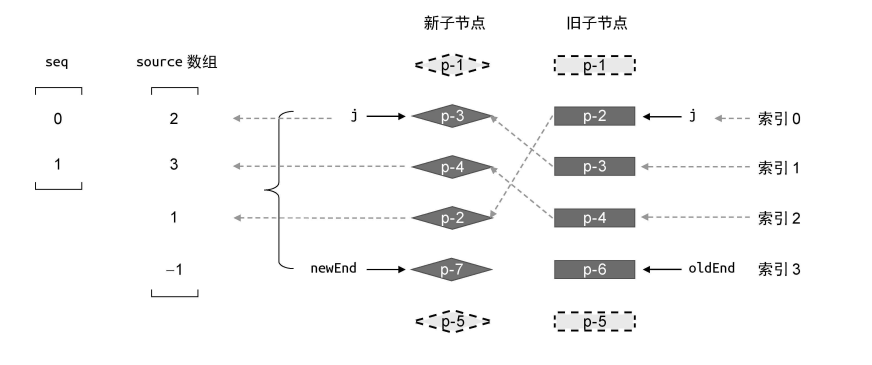
we will get the longest subsequence named sepsource
seq: [0,1]
and define two variable si
s: it is a lastindex of seq i: it is a lastindex of oldChildren[start-end]
compare iseq[s]

if (moved) {
const seq = getSequence(source)
let i = count - 1
for (i; i >= 0; i--) {
if (source[i] === -1) {
// meaning the key of newChildren not in oldChildren, so we will add it
const pos = i + newStart
const newVNode = newChildren[pos]
const nextpos = pos + 1
const anchor = nextpos > newChildren.length ? newChildren[nextpos].el : null
patch(null, newVNode, container, anchor)
}
else if (i !== source[i]) {
// meaning moving
const pos = i + newStart
const newVNode = newChildren[pos]
const nextpos = pos + 1
const anchor = nextpos < newChildren.length ? newChildren[nextpos].el : null
// move
insert(newVNode.el, container, anchor)
}
else {
// don't need move
i--
}
}
}
function getSequence(arr) {
const p = arr.slice()
const result = [0]
let i, j, u, v, c
const len = arr.length
for (i = 0; i < len; i++) {
const arrI = arr[i]
if (arrI !== 0) {
j = result[result.length - 1]
if (arr[j] < arrI) {
p[i] = j
result.push(i)
continue
}
u = 0
v = result.length - 1
while (u < v) {
c = ((u + v) / 2) | 0
if (arr[result[c]] < arrI)
u = c + 1
else
v = c
}
if (arrI < arr[result[u]]) {
if (u > 0)
p[i] = result[u - 1]
result[u] = i
}
}
}
u = result.length
v = result[u - 1]
while (u-- > 0) {
result[u] = v
v = result[u - 1]
}
return result
}
if (moved) {
const seq = getSequence(source)
let i = count - 1
for (i; i >= 0; i--) {
if (source[i] === -1) {
// meaning the key of newChildren not in oldChildren, so we will add it
const pos = i + newStart
const newVNode = newChildren[pos]
const nextpos = pos + 1
const anchor = nextpos > newChildren.length ? newChildren[nextpos].el : null
patch(null, newVNode, container, anchor)
}
else if (i !== source[i]) {
// meaning moving
const pos = i + newStart
const newVNode = newChildren[pos]
const nextpos = pos + 1
const anchor = nextpos < newChildren.length ? newChildren[nextpos].el : null
// move
insert(newVNode.el, container, anchor)
}
else {
// don't need move
i--
}
}
}
function getSequence(arr) {
const p = arr.slice()
const result = [0]
let i, j, u, v, c
const len = arr.length
for (i = 0; i < len; i++) {
const arrI = arr[i]
if (arrI !== 0) {
j = result[result.length - 1]
if (arr[j] < arrI) {
p[i] = j
result.push(i)
continue
}
u = 0
v = result.length - 1
while (u < v) {
c = ((u + v) / 2) | 0
if (arr[result[c]] < arrI)
u = c + 1
else
v = c
}
if (arrI < arr[result[u]]) {
if (u > 0)
p[i] = result[u - 1]
result[u] = i
}
}
}
u = result.length
v = result[u - 1]
while (u-- > 0) {
result[u] = v
v = result[u - 1]
}
return result
}
so far, the analysis of vue diff algorithm has ended.